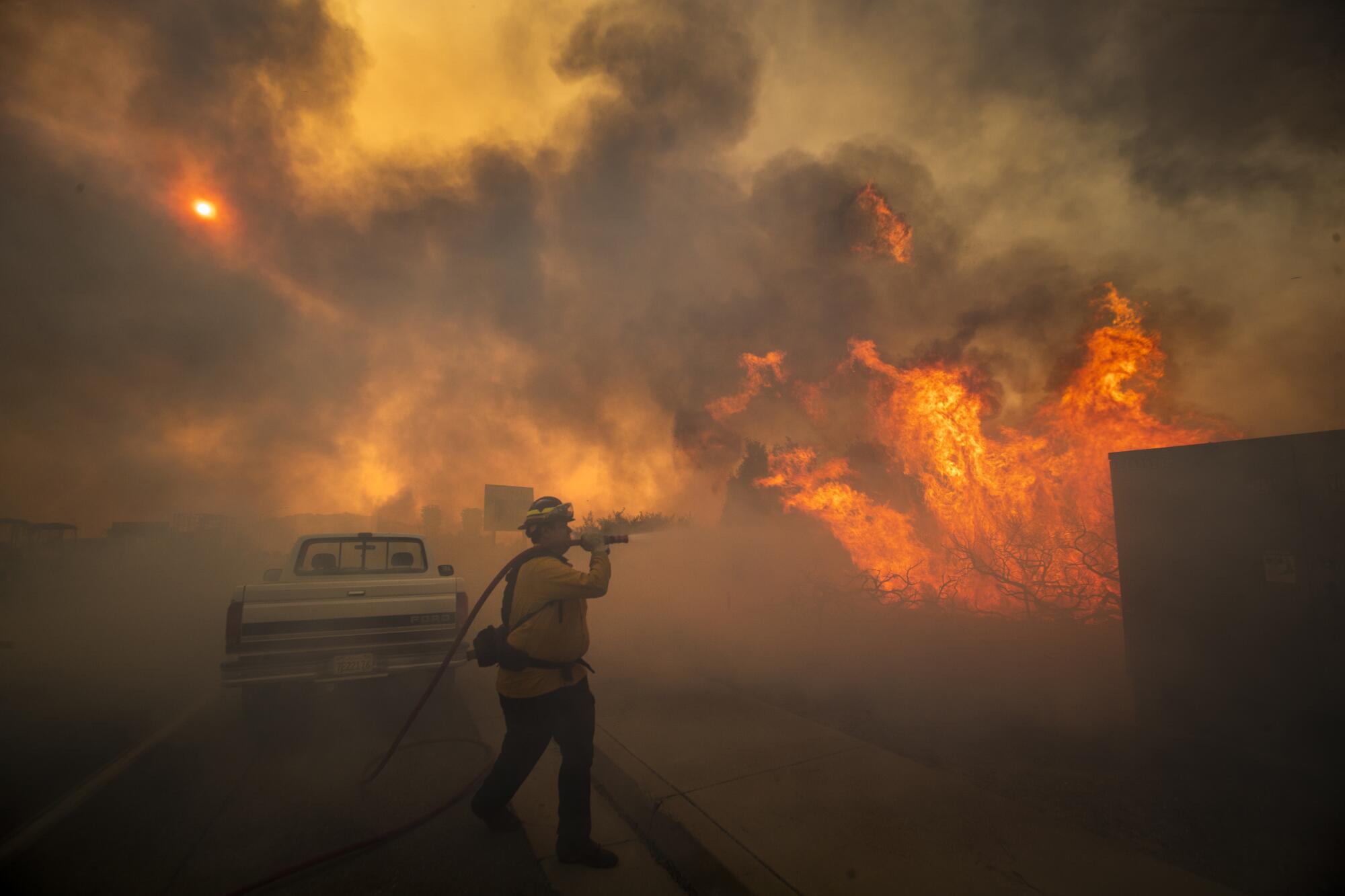-
30 hurt when car slams into crowd in Hollywood - 9 hours ago
-
Astronomer CEO Andy Byron Placed on Leave After Video at Coldplay Concert Exposes Alleged Affair - 16 hours ago
-
Blood in the Streets and Death in the Air: Residents Survey Damage in Syrian City - July 17, 2025
-
Army vet calls for investigation after being detained for three days in ICE raid - July 17, 2025
-
Tariffs Push Up Prices, and the Supreme Court’s ‘Shadow Docket’ - July 16, 2025
-
ICE arrested her selling tamales at Lowes. Then she suffered a heart attack. ‘I told them: I can’t breathe’ - July 14, 2025
-
The Royal Box: Who’s in Wimbledon’s Most Exclusive Seats? - July 13, 2025
-
David Gergen, Adviser to Presidents and Political Commentator, Dies at 83 - July 12, 2025
-
Federal judge temporarily halts alleged indiscriminate immigration stops - July 12, 2025
-
Coal, the Last Survivor of Canada’s Parliament Hill Cat Colony, Dies - July 10, 2025
When Santa Ana ‘devil winds’ arrive, L.A. takes notice
There may be no weather pattern more iconically associated with Los Angeles than the Santa Ana winds.
One of the earliest written descriptions of the Santa Anas comes from the diary of Commodore Robert Stockton on the night of Jan. 6, 1847; the next day his forces captured Los Angeles on behalf of the United States.
And as the city has grown to assume a prominent place in American pop culture, it has given global renown to this local phenomenon, name-dropped by Raymond Chandler, Nancy Meyers and the Beach Boys.
The Santa Ana winds are notorious for being hot, dry, and dusty — traits that have earned them the nickname “devil winds” — but the quality that really defines them is their direction.
Unlike the prevailing winds in Southern California, which flow generally from west to east, carrying temperate air from the Pacific, the Santa Anas flow from northeast to southwest out of the Mojave Desert. What causes this reversal, and why does it produce such a diabolical result?

Aggressive and impactful reporting on climate change, the environment, health and science.
To form the Santa Ana winds, the typical first ingredient is a chilled autumn day in the high desert of southern Nevada.
The chill creates cold, dense air, which is squeezed from aloft by a high pressure system. Normally the surface air would be contained within the Great Basin formed by the Sierra Nevada and Rocky Mountains, but the second ingredient is a low pressure system off the California coast, which creates enough gravitational potential to force the air out of the basin and pull it west toward the Pacific.

As it flows downhill, the air is compressed due to the higher weight of the atmospheric column above it. The ideal gas law (PV=nRT, if high school chemistry is just a hazy memory) tells us that when the pressure on a gas increases, its temperature does too. The result is that the descending air heats up by almost 30 degrees Fahrenheit for every vertical mile it sinks.
The dry desert air, warmed by its descent, rushes toward the coast. But the Transverse Ranges stand in the way, so the air seeks the path of least resistance through the Cajon and San Gorgonio passes. Like water spraying through a narrow nozzle, the winds are accelerated as they enter the canyons, often reaching gale-force strength by the time they exit into Los Angeles and San Bernardino.
A mild Santa Ana wind can be irritating, giving people nosebleeds and blowing sand in their eyes, but the more severe events can have deadly consequences. The most obvious risk is the high winds — during a particularly forceful episode in December 2011, gusts in excess of 50 mph toppled trees, damaged hundreds of buildings and knocked out power to hundreds of thousands of people.
The atypical wind direction can pose a specific risk for boats and maritime infrastructure, as harbors that are usually well protected on the leeward side of the Channel Islands are suddenly exposed to forceful gusts and waves.

Strong offshore Santa Ana winds blast incoming waves at Huntington Beach in October 2018.
(Allen J. Schaben / Los Angeles Times)
An even greater danger comes from the increased potential for wildfires. Hot, dry air can rapidly extract moisture from vegetation, especially when that air is being continuously replenished by strong desert winds. The Santa Anas often bring triple-digit temperatures and a relative humidity below 10%, leading to drier fuel that can ignite more easily. Moreover, strong winds cause fires to grow and spread more quickly, since the winds provide a steady supply of oxygen, carry sparks and even bend the flames closer to the unburned material ahead of the fire.
In the last few decades, Santa Ana winds have been associated with several large wildfire clusters, including the 2007 Witch Creek fire, the 2008 Sayre fire and the 2017 Thomas fire, which was the largest wildfire in state history at the time.

A firefighter battles the Silverado fire amid heavy Santa Ana winds in Irvine in October 2020.
(Allen J. Schaben / Los Angeles Times)
Until recently, the Santa Ana winds were thought to be one of the few bright spots in climate change; a paper from 2019 predicted a future decrease in the frequency of Santa Ana winds, particularly in September and October. The authors suggested that this is due to a projected northward migration of the “Great Basin high” that tends to form over Nevada.
However, recent analysis published two years later by the same authors suggested that the decreasing trend was mostly confined to a distinct “flavor” of Santa Ana winds that, while they originate from the same location, are caused by a different mechanism and bring intense cold to Southern California instead of heat.
Although these “cold Santa Anas” can still cause wind damage, they are not typically associated with wildfire activity, and a decrease in frequency would have little effect on fire risk. Unfortunately, it seems those hot, dry days when the wind stings your eyes and sparks fly are here to stay.
Ned Kleiner is a scientist and catastrophe modeler at Verisk. He has a doctorate in atmospheric science from Harvard University.
Source link









